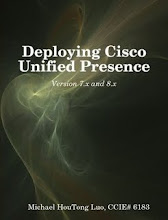Cisco has many software running on x86 platform. We'll discuss Unified Communication products here - CUCM, CER, UCCX, etc.
CUCM
CUCM is the flagship of Cisco UC products. You may install CUCM on VMWare just fine. No hacking is required, but you'll receive a warning that VMWare is not "officially" supported. ie. you shouldn't use it in production. Cisco planned to support VMWare in production in the future ( probably with UC 8).
Though you may install CUCM on VMWare, there are some limitations.
Limitation #1 Licensing
Cisco limits the number of nodes and DLUs on a VMWare MAC address. (3 nodes, 125 DLUs at the time I'm writing this blog). If you should need more than 3 nodes and 125 DLUs, you may change the MAC address of the CUCM (change in VM guest, not in VM host). Just Google keywords "change MAC address on Linux" and you'll find the answer.
Limitation #2 SNMP Agent
You'll notice that "SNMP Master Agent" service fails to start if CUCM was installed on VMWare. This will cause problem if you're testing CER (Emergency Responder). CER needs SNMP connection to CUCM to retrieve phone info. The workaround would be issue the command on CUCM root shell "/sbin/chkconfig snmpd off". Then reboot the server.
Limitation #3 VMWare Acknowledgement
Since from version 7, CUCM requires you acknowledge the "VMWare agreement" during startup. If you reboot the CUCM remotely (either via OS Admin web or via CLI), the server will not boot up until you press the "Agree" button on the console. The workaround is to edit /usr/local/bin/base_scripts/hardware_check.sh,
change the line
if [ "$hwmodel" = "vmware" ];
to
if [ "$hwmodel" = "foobar" ];
On newer versions,
Change the line
if isHardwareUnsupported || isOriginalHardwareUnsupported ; then
To
#if isHardwareUnsupported || isOriginalHardwareUnsupported ; then
if 0 ; then
CER
Besides the limitations mentioned about, CER has another limitation with VMWare.
CER retrieve information from CUCM via SNMP. This includes the machine type of CUCM. If CUCM is running on VMWare, the machine type will be "unsupported" from CER point of view. The workaround is to edit /usr/local/CER/etc/devices.xml file on the CER box. Add the following tag under "CcmHost" family tag:
member OID="1.3.6.1.4.1.99.1.1.3.28" OIDNAME="vm-ware" CAPTION="VMWare"
UCCX
So far, UCCX has been running on "Cisco OS" 2000/2003, which in fact is Windows 2000/2003. However, UCCX will refuse to install if Cisco specific registry key is missing. Follow instructions on http://www.tek-tips.com/viewthread.cfm?qid=930128&page=1 to add the registry key.
Good news is: VMWare is supported since Cisco OS 2003.1.4. If you're using OS 2003.1.4 or newer, you don't need the registry hack.
Another tips is: if you want to bypass the hard drive/memory requirement check, you may create an empty file named "crstest.ini" on C:\. Then CRS won't require 72G HDD/2G memory to install. Of course, this is for testing purpose.
Root shell on UC appliance
Many of the hacking above requiress the root access to the appliance (CUCM, CER, etc.). Just use Google to find the answer. For example: http://www.blindhog.net/how-to-get-root-access-on-call-manager-56-server/

